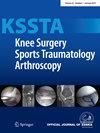Management of first-time patellar dislocation: The ESSKA 2024 formal consensus—Part 1
Abstract
Purpose
To provide recommendations for the treatment of patients with first-time patellar dislocation (FTPD). Part I focused on clinical presentation, symptoms, diagnosis, evaluation and imaging.
Methods
Fifty-four orthopaedic surgeons and one physiotherapist from 20 countries across Europe were involved in the consensus, which was the FTPD. The consensus was performed according to the European Society for Sports Traumatology, Knee Surgery and Arthroscopy consensus methodology. The steering group designed the questions and prepared the statements based on the experience of the experts and the evidence in the literature. The statements were evaluated by the ratings of the peer-review groups before a final consensus was released.
Results
The consensus consists of 32 questions and statements, 13 of which will be reviewed in Part 1 of the review. There is an inverse correlation between the intensity of trauma leading to FTPD and the underlying pathoanatomic risk factors, meaning that low trauma intensity usually indicates more severe underlying abnormalities. In addition to the clinical investigation, patient age, family history, bilateral symptoms of instability and injury mechanism should be evaluated. However, reliance can be placed not only on clinical examination but also on magnetic resonance imaging scans as soon as possible, which are considered mandatory for evaluating predisposing factors such as trochlear dysplasia and patella alta and for detecting osteochondral lesions, with the exception of asymptomatic patients. Importantly, it must be recognized that in addition to recurrent instability, which affects approximately 25% of patients, a variety of symptoms are experienced by 50% of patients, such as pain, swelling, giving way, functional and psychological limitations, and a reduction in sports participation, all of which reduce their quality of life. The complications after medial patellofemoral ligament reconstruction in patients with FTPD have not yet been established; however, we know from cohorts of heterogeneous patients that the most common complications are patellofemoral pain, a reduced range of motion and patellar fracture. In total, there were 13 statements that were all accepted and achieved, 6 with strong agreements and 7 with relative agreements. The general median agreement was 8 (range 7–9). None were graded A, two were graded B, seven were graded C and 4 were graded D.
Conclusion
In relation to the management of patients with first-time patellar luxation, we have worked with 13 questions and based on these we have achieved consensus on 13 statements.
Level of Evidence
Level I, consensus.

 求助内容:
求助内容: 应助结果提醒方式:
应助结果提醒方式:


